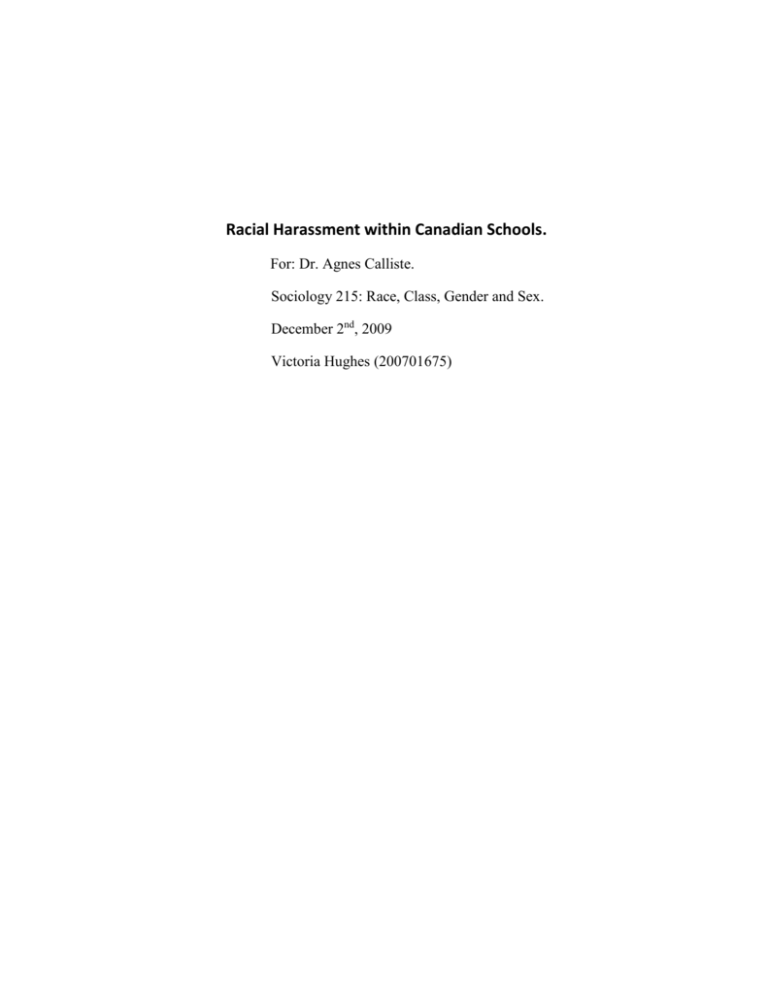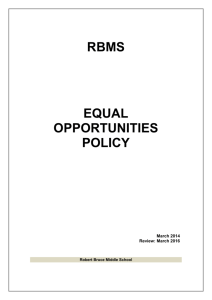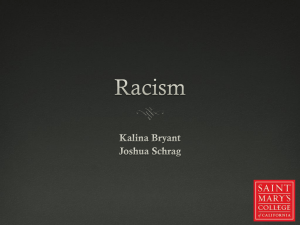race final paper
advertisement

Racial Harassment within Canadian Schools. For: Dr. Agnes Calliste. Sociology 215: Race, Class, Gender and Sex. December 2nd, 2009 Victoria Hughes (200701675) Racism exists all over the world and is experienced by individuals of all ages, races and cultural backgrounds. Racial harassment in education institutions includes racial slurs and ethnic and racial jokes. In this essay two specific racial harassment incidents have taken place within Canadian schools will be discussed and what effective measures need to be taken to prevent incidents such as these from ever happening again. Reena Virk was a 14-year-old female South Asian student from Victoria, British Columbia. On November 14th 1997, she was brutally beaten by eight teens from her school. Reena survived the first brutal beating, after six of the teens left she got up bruised and battered and attempted to walk home. Two of her attackers followed her, continued to beat her up and eventually drowned her in a nearby gorge. A week later, Reena’s body was found. According to Reena’s parents she suffered from low self-esteem, endured years of teasing by her classmates and felt very insecure. She was humiliated and bullied by classmates because she did not “fit in” due to the colour of her skin and constantly teased about her appearance. “In a White society, her skin colour was brown; in a society that values thinness, she was perceived as overweight.”1 Bullying someone because of the color of their skin is classified under the definition of racism. Reena was racially harassed in a place where not only just her parents, but all of her classmate’s parents send their children to be educated on subjects of math, social studies and especially respect. Anyone who has attended school remembers the dozens of posters displayed in classrooms, hallways and principles offices advertising respecting others and respecting the environment they learn in. In Reena’s case, she was sent every day to place where she was the target of bullying, harassment and cruelty every moment she spent in that school year after year. This unfortunate and fatal incident leaves society wondering how her teachers did not over hear 1 Frances Tator and Carol Tator. “The Colour of Democracy-Racism in Canada” 4th edition. Nelson Education 2010. P.209 any of this harassment and why nothing was done to protect young Reena. According to a 1996 Statistics Canada Census “The visible minority population has reached 3.2 million which is 11.2% of the Canadian population.”2 Therefore the number of visible minority children in Canadian schools is growing. As the number of minority races in Canadian classrooms rises education departments need to reflect on changing the pace of anti-racism issues taught in classrooms to create a more welcoming and equal environment for children of minorities. In June 2004 the Vancouver school board released a report describing another incident of racial harassment involving a student at a high school in Vancouver. The report involved name-calling, stereotyping and violence based on race and ethnicity. The report recommended that anti-racism and multiculturalism be a priority in all schools. According to our textbook “The Colour of Democracy-Racism in Canadian Society” “Teachers often had very little knowledge or understanding of other cultures, which inadvertently led both teachers and students to trivialize and stereotype different ethnic and racial groups.”3 This describes the need for teachers to undergo professional development days devoted to racism training as well as perhaps information sessions regarding different cultural backgrounds. In November 2008, Queen’s University student Rachel Kucharczuk was the victim of her first experience of racial harassment. Rachel was getting into her car in Kingston Ontario when she discovered four swastikas on the windshield of her car. After a trip to the grocery store she was opening her trunk to get her reusable grocery bags when she then discovered four more swastikas and the words “Dirty Jew” written on her back window. Rachel reported this incident to the Queen’s University campus police, the Kingston Police Department and The Canadian 2 http://www.crr.ca/divers-files/en/pub/faSh/ePubFaShRacScho.pdf Frances Tator and Carol Tator. “The Colour of Democracy-Racism in Canada” 4th edition. Nelson Education 2010. P.214 3 Jewish Congress. They deemed this incident as a hate crime. Rachel described this as the first time she had been discriminated for her religious beliefs in her four years as a student at Queen’s. According to Leora Jackson a representative of Queen’s University “the issue of racism on campus has come to the forefront this year.”4 Incidents of racism and racial harassment such as this case have risen over the past couple months at Queen’s. Although these incidents are not receiving the amount of publicity among Ontario newspapers, the school’s Journal has published them in an attempt to educate and inform the student body of these discriminating events. The subject of racism cannot simply be ignored. Acts of discrimination on university campuses needs to be addressed and classes of racism education need to be implemented into course selection such as at St. Francis Xavier. This is a good example of racism not only being targeted towards skin colour, but also religious backgrounds and beliefs. These two incidents involve a young teenage girl and a university student, proving that racial harassment can happen to anyone of all ages and doesn’t necessarily take place in one specific educational setting. According to the Canadian Race Relations Foundation, prevention of racism in our Canadian schools must start with parents. Early racism education must begin in the home. Parents must set good exams for their children by examining their own prejudices and remember that their own verbal messages conveyed between adults in a home are heard by children. “Don’t avoid the question or pretend discrimination doesn’t exist: be ready to discuss feelings, emotions, prejudices, and uncertainties honestly.”5 Parents should be able to discuss racism openly and honestly with their children. Education within the home allows for children to then bring what they’ve learned to the school. Parents should always be prepared to honestly answer questions children bring home at the end of the day regarding racism. 4 5 http://www.queensjournal.ca/story/2008-11-14/news/another-racist-incident-reported/ http://www.crr.ca/divers-files/en/pub/faSh/ePubFaShRacScho.pdf In conclusion, in order to reduce the amount of racial harassment incidents within Canadian schools, teachers must be educated about the subject of racism and set good examples in their own classroom. Also school boards need to hire more social workers to be readily available for students to talk to if they feel they are being bullied for any reason including because of their race. In Canadian history racism was completely absent from school curriculums. It has since then become more common among Canadian Education Departments to introduce anti-racism educational sessions within schools. Guest speakers could be invited to schools to give first-hand accounts of what it feels like to be racially harassed and discriminated against. Finally, the video Brown Eyes Blue Eyes should be shown in every elementary school across Canada to allow all children to experience what it is like to feel excluded for having a specific feature that is considered to be out of the “norm”, more importantly there should no “norm” and all races, cultural backgrounds and religious beliefs should be treated equally. If these steps are introduced into school systems then perhaps the amount of race related discrimination cases would be lowered.







